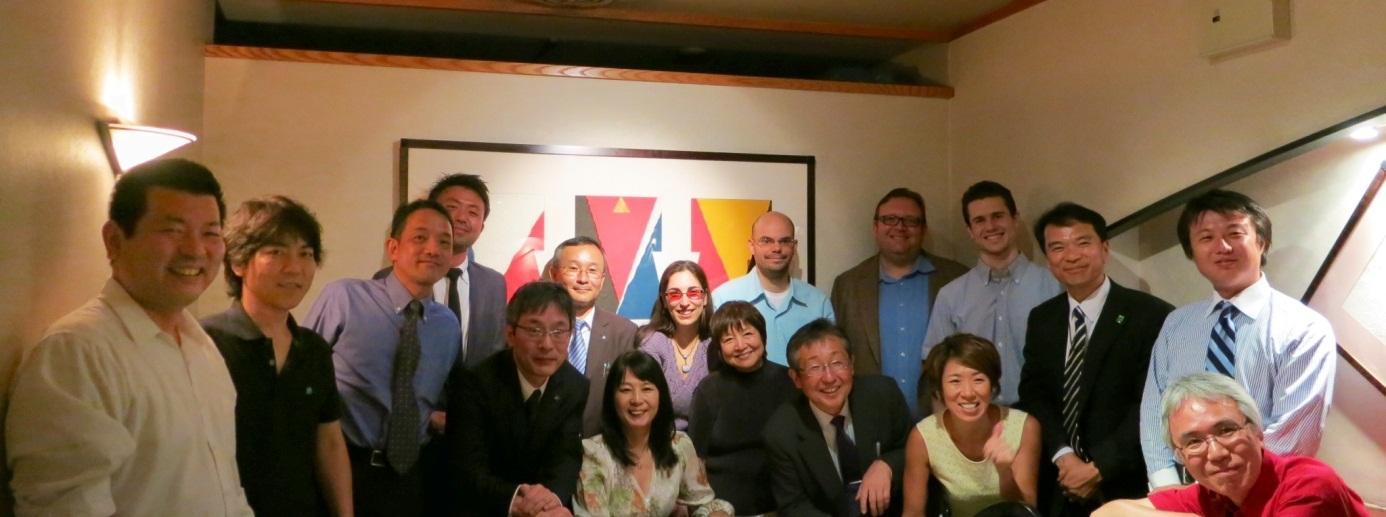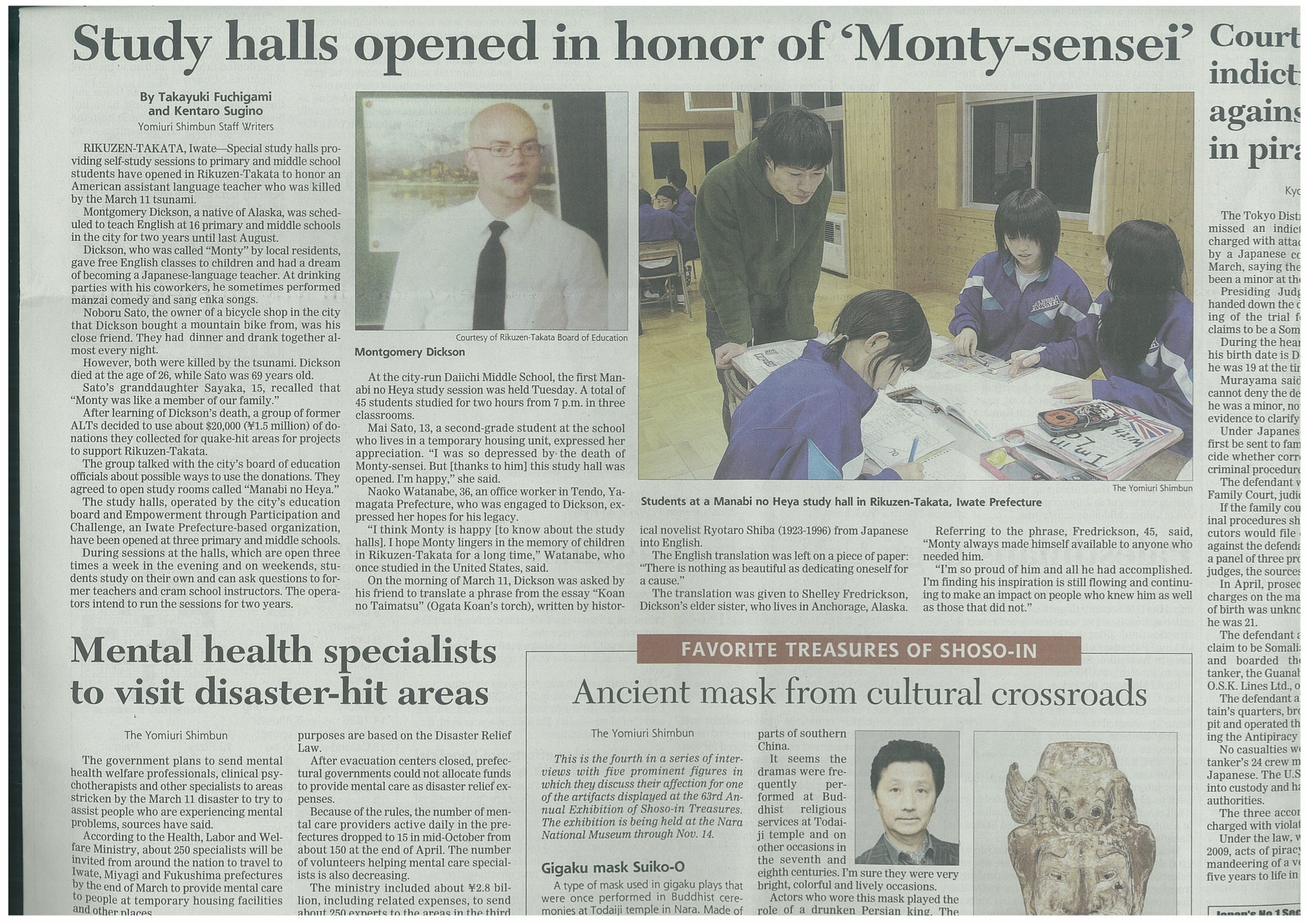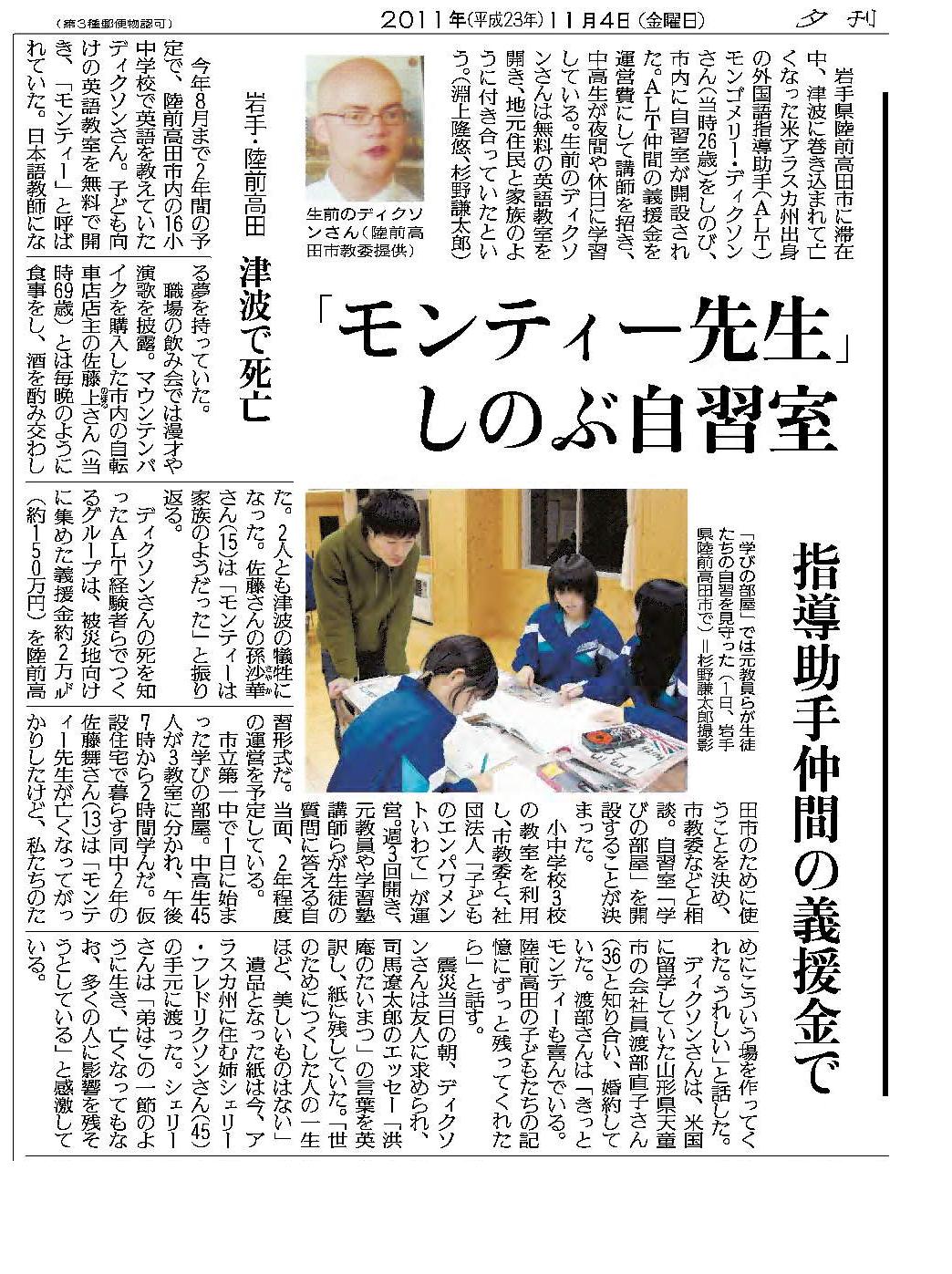Fukui JET alumni meet Fukui Group in New York
Four Fukui JET alumni participated in a recent exchange meeting with a delegation from Fukui Prefecture (led by the incumbent Governor Nishikawa) and the Fukui Association (Fukui Kenjinkai) in New York.
The alumni happily spoke with the governor and others about their memories of JET life in Fukui, artworks on traditional Echizen paper (Echizen-Washi), plays featuring the sometimes amusing daily life in Fukui, and many other topics.
Japan Local Government Center (NY) Newsletter (July 2012)
Here’s the July 2012 issue of the Japan Local Government Center (aka CLAIR New York) Newsletter: http://www.jlgc.org/pdfs/en/news73.pdf
Content includes:
No.73 (July 2012)
・A Greeting from the New Executive Director (1-2)
・Comments from ICMA International Committee’s Japan Tour Participants (page 3-7)
・Comments from JETAA members who volunteered at the JLGC booth in the New York Times Travel Show 2012 (page 8-10)
・Introduction of JLGC New Staff (page 11)
・JLGC New Staff visited Novi, Michigan (page 12)
Hawaii JET alums volunteer as Hiroshima City Mayor Matsui leads visiting delegation (Japanese article)
*******************
JETwit recently posted a JETAA Hawaii article by chapter President Darryl Toma about Hawaii JET alums volunteering to support a visit by the Hiroshima City Mayor along with a visiting delegation from Hiroshima.
FYI, there’s also now an article in Japanese about Mayor Matsui’s visit on the Japan Local Government Center (aka CLAIR-NY) blog: http://www.jlgc.org/TopicList.aspx?topicCategoryID=16&topicID=279&languageTypeID=2&controlType=Display
CLAIR Forum Vol. 273
Here’s a link to the latest issue of CLAIR Forum (Vol. 273), featuring an article on the Great East Japan Earthquake.
Other notable articles include:
- Contributions from Andy Anderson, Cameron Peek (current Miyagi CIR) and William McMichael (former Fukushima CIR) (Andy’s original English version is also included in the link above. You can find Cameron and William’s original English versions here.)
- An article by Satoko Kanesh about JETAA support, with emphasis on activities of JETAANY. (only Japanese available)
Hawaii JET alums volunteer as Hiroshima City Mayor Matsui leads visiting delegation
Via JETAA Hawaii. Go to their site for photos and video:
“This past weekend (June 8-10), the Pan-Pacific Festival took place in Hawaii, which involved a range of events, even including a parade through Kalakaua Avenue with groups from all over the Pacific Rim.
Joining the festivities was Mayor Matsui and some of his delegates all the way from Hiroshima. Through the Japan Local Government Center (JLGC – CLAIR) in New York, JETAA Hawaii had the opportunity to assist the Mayor in some of his tourism promotion activities.
At the first event (June 9, Saturday), JET alumni Keith Sakuda, Kristine Wada, and Darryl Toma joined Mayor Matsui at Ala Moana Center Stage to give a presentation on Hiroshima and promote some of its famous and not-so-famous attractions that include the Peace Park Memorial and Museum, Atomic Bomb Dome, Miyajima, Okonomiyaki, Momiji Manju, Mazda Stadium (baseball), as well as some of the upcoming events such as the 2013 Hiroshima Confectionary Expo (April 9 – May 12, 2013) and Hiroshima Flower Expo. Following their presentation, a Kagura dance group performed on stage.
At the second event following the presentation at Ala Moana Center Stage, Keith, Kristine, and Darryl joined up with fellow JET alumni David Tokuda, Christine Toyama, and Reid Yamada to have lunch with Mayor Matsui and some of his tourism promotion delegates. Discussion topics varied, including JET alumni experiences, teaching methods, impressions of Hiroshima, and suggestions for improving tourism promotion for Hiroshima.
The next day (June 10, Sunday), JET alumni David Tokuda and Darryl Toma joined the Mayor and his delegation, along with a representative from the JLGC, to promote tourism to Hiroshima in Waikiki. Passerbyers filled out questionnaires about Hiroshima, received free information packets that included origami, and had chances to win a variety of prizes from Hiroshima that included brushes, beads, and various pottery.
Overall, the JET alumni that participated had a great time assisting Mayor Matsui and his delegation with their activities and look forward to future opportunities to assist them, as well as the JLGC.
A big thanks goes out to Mayor Matsui from Hiroshima City for giving JETAA Hawaii this opportunity. We would also like to thank Mayor Matsui’s delegation for their great support throughout each event. In addition, we would like to thank Naomi-san and everyone from JLGC in New York for her great support in coordinating everything. Last but not least, thank you very much to Lisa from the Honolulu Japan Consulate for assisting in coordination and of course, all of the JET alumni who participated in these events.
We will look forward to the next time we can meet!”
Attention JET alums in Hawaii: Support Requested for Hiroshima City Delegation at the Pan-Pacific Festival
Via the Hiroshima City Government with assistance from Naomi Maki of the Japan Local Government Center in New York (aka CLAIR-NY):
A tourism promotion and exchange delegation from the City of Hiroshima is visiting Honolulu!
Purpose: Hiroshima City and Honolulu City established a sister city relationship in 1959, and over the years, they have enhanced their friendly relations through promoting peace, culture, sports, and other causes. In 2009, they exchanged delegations in commemoration of the 50 years of their sister city relationship. Also the Hiroshima Chamber of Commerce and the Honolulu Japanese Chamber of Commerce established a relationship in 1971, and last year was the 30th anniversary for them. So this year, the City of Hiroshima and the Hiroshima Chamber of Commerce are sending a delegation to Honolulu to promote tourism in Hiroshima. They will visit Honolulu by a charter flight with around 200 citizens.
Schedule: From June 7 to 12
Support Requested for Hiroshima City Delegation at the Pan-Pacific Festival in Honolulu, Hawaii
We are looking for JET alumni who worked in Hiroshima on JET, because the City of Hiroshima would appreciate any volunteers who might be able to help with their tourism promotion in Honolulu on the following dates:
*From 11:20am to 11:35 on June 9, Saturday for a stage event.
*From 3:00pm to 7:00pm on June 10, Sunday for distributing Hiroshima’s tourist information at a booth.
If you or any other JET alumni know someone who worked in Hiroshima as a JET, please share this information. If anyone is interested in this program, please contact Darryl Toma, President of JETAA Hawaii at Jetaahawaii [at] gmail.com.
And if you are interested in Hiroshima and connecting with other Hiroshima JET alumni, please join the Hiroshima JET Alumni group on LinkedIn!
Also CLAIR and the City of Hiroshima would greatly appreciate it if JET alumni could share the above information with other JET alumni.
From Naomi Maki, Assistant Director, Japan Local Government Center.
About the Pan-Pacific Festival: http://www.pan-pacific-festival.com/index.html
Job: Economic Advisor, Embassy of Japan (London) 03.30.12
Via JETAA UK. Posted by Kay Monroe (Miyazaki-shi, 1995 -97).
———————————————————————————————————————–
The latest from JETAA UK – Job Vacancy
Economic Advisor, Embassy of Japan – Embassy of Japan in the UK – Embassy of Japan, London, W1J 7JT
To view details about this job vacancy visit: http://www.jetaa.org.uk/jobs/economic-advisor-embassy-of-japan/
************
Pretty amazing and I assume extremely unusual tale captured by the Japan Times (and forwarded to me by former JETAANY President and current JETAA USA Country Rep Megan Miller (Hyogo-ken). On one hand, it sounds like a combination of cultural differences plus some people with bad ethical judgment. On the other hand, perhaps it’s indicative of some of the financial pressures affecting small (or relatively small) towns in the current economy in Japan.
Teacher outfoxes board, exposes bid to fleece JETs
http://www.japantimes.co.jp/text/fl20120228a1.html
By PATRICK BUDMAR
English teachers on the JET program are often faced with the bittersweet moment when they realize their contract is ending and they will soon be returning to their home country.
However, for one former JET teacher, that moment turned out to be a poisonously sour one as he became embroiled in a conflict with the board of education (BOE) that employed him. Read More
The Best Prefectures: By JET Alum LinkedIn Groups – Update 02.09.12
You may recall last year (02.21.11 to be exact), JETwit revealed the “Best Prefectures” based on how many members each LinkedIn JET Alum prefecture group had. With a little help from JETwit’s friends, we’ve updated the numbers, and they now total 787 total members.
Shimane-ken continues to kick prefectural oshiri in a big way. Not sure what’s holding back JET and JET alums from other prefectures. But all you have to do to join your prefecture LinkedIn group is to click here and find your prefecture. A great way to not only stay connected with your community, but also to provide Return On JET-vestment at the local level. (Click here for more explanation about why this helps “save” JET. And click here for a list of JET alum LinkedIn groups by profession.)
The Top JET LinkedIn Prefecture Groups
(last year’s numbers in parentheses)
1. Shimane – 69 (44)
2. Fukushima JET Alumni – 38 (14)
2. Hokkaido – 38 (16)
4. Fukui JET Alumni – 32 (11)
4. Hyogo JET Alumni – 32 (12)
4. Niigata JET Alumni – 32 (16)
**************
Overall Ranking of JET Alum LinkedIn Groups by Prefecture
(in alphabetical order; last year’s numbers in parentheses) Read More
JQ Magazine: JQ&A with JUSTE Program Participant Kazumoto Takechi
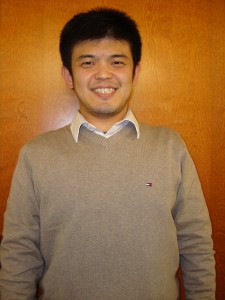
"I would like the duration of stay in this project extended as long as possible. Hopefully, this project will revolutionize Japanese English education just as the JET Program has changed the landscape of English language education in Japan."
By Sierra Soleil (Fukushima-ken, 2000-02) for JQ magazine. Sierra works at an ESL school in Manhattan. He enjoys teaching, writing, and riding his bike.
It’s been called the “Reverse JET Program,” which is a lot catchier than the Japan-U.S. Training and Exchange Program for English Language Teachers (JUSTE Program). A few of the East Coast JUSTE teachers made a special public appearance at the JETAANY Welcome Back Reception in November, and since then there has been some talk about exactly what this program is, and what these teachers are up to.
Recently, Kazumoto “Kaz” Takechi, a JUSTE participant at Rutgers University in New Jersey, took some time out of his busy schedule to answer a few questions about his experience as a Reverse JET. Spoiler alert: the program is very new, and its future is not assured, especially with the budget restrictions caused by the problems in Fukushima. However, if Kaz’s attitude is at all typical of the other participants, JUSTE could be every bit as much of a game-changer as JET was.
Kaz got his MA in English education from Naruto University of Teacher Education in 2002, and works at Ishii Junior High School in Tokushima, Shikoku. He was nominated by the program as one of 96 Japanese teachers of English to spend six months in the U.S. through January of this year, and is the only JUSTE teacher from Tokushima. Before he got to my questions, Kaz started with a shout-out to his former ALTs:
“All of my ALTs have been great partners in the classroom. I am a very lucky teacher because I have met very wonderful ALTs during my nine years as an English teacher. I am really glad to participate in this article for ALTs.”
Where did the idea come from to send teachers to the U.S. in order to improve English education in Japan?
According to the Foreign Ministry Advance Institute Workshop held at Tokyo in May 2010, both Japan and the United States agree that the two countries need to foster mutual understanding at the citizen level in order to sustain and strengthen the Japan-U.S. alliance. Based on this agreement, a summit conference between Japan and the U.S. was held in Yokohama on November 13, 2010. Details on how to strength our relationships were finalized during this conference. The JUSTE project is a direct outcome of this conference. The Ministry of Education further defined that the JUSTE project had two objectives. One is to foster and develop the English communicative skills of Japanese English teachers. The other is to develop Japanese English teacher pedagogical skills through TESOL classes offered at U.S. institutions.
Has this idea been around for a long time, or was it a recent initiative?
The Ambassador Plenipotentiary has wished that this project take motion for some time. He has consistently envisioned the necessity to give Japanese English teachers the opportunity to seek professional development, in English speaking countries such as the U.S., after they become certified English teachers in Japan. He has consistently suggested this to the government, and thanks to his wonderful efforts this project has finally materialized.
How would you assess the progress so far?
At this juncture, I am focusing on developing the skill sets that will contribute to the professional development of Japanese English teachers and ALTs when I return to Japan. I will be presenting to the English language teacher community as well as conducting demonstration lessons to assist in their professional development. Moreover, I will also write some articles about my experience in this project. Hopefully, I will inspire other English teachers and muster support for this project among supervisors and English language teachers. This is a challenge I am embarking on, but I have conviction that my actions will positively influence other English teachers and the future of Japanese English education.
Daily Yomiuri: “Study halls opened in honor of ‘Monty-sensei'”
***********
JETAANY held its annual Career Forum/Welcome Back Reception on Saturday at the Nippon Club in NYC. And in addition to the usual combination of useful advice, networking, natsukashii talk and reconnecting in general, this year’s Welcome Back Reception was notable for one other reason: It was attended by approximately 25 participants in Japan’s new Japan-U.S. Training Training and Exchange Program for English Language Teachers (JUSTE) program, sometimes referred to as the “Reverse JET” program.
The program selected 96 Japanese teachers of English to spend 6 months in the U.S. studying ESL teaching methodology–in English–at 6 different universities across the U.S.: Rutgers University (NJ), University of Delaware, University of Michigan, University of Texas, University of Iowa, UC Irvine and UC Davis. The teachers are in turn supposed to bring back their learning and share it with their respective school systems as part of an effort to improve English ability of Japanese students.
The Reverse JETs attending on Saturday came up from Rutgers and the University of Delaware. It was a terrific opportunity to get to know them and learn more about the program. Following a brief intro by all of the returning JETs, the Reverse JETs were asked to do the same. And as they said their names and prefectures, there was an almost instant connection as JET alums from various prefectures cheered when the Reverse JETs called out their own home prefecture.
It was also apparent that these were top rate teachers–the really genki, creative and engaged teachers you remember from your JET days. (We all were fortunate to have had at least one of these if not more.) This was made rather apparent when the Delaware contingency decided to forego the traditional introduction style and instead go with a teaching game they had all learned in class the day before. (See video below.)
Throughout the reception and the nijikai at Faces & Names, JET alumni found the Reverse JETs extremely friendly and easy to talk to. And it was interesting to hear about their situations and the parallels with our own first time experiences in Japan. For example:
- While the Rutgers participants are all living on campus in a dormitory for foreign students, the Delaware participants are all living with homestay families and generally need to rely on them for transportation to and from the campus (as they’re not permitted to drive while in the U.S.)
- Most participants were surprised to have been selected for the program. That’s because most of them hadn’t even known of the program’s existence until their principals called them into their offices and asked them if they’d like to go to the U.S. for 6 months. In same cases, participants only had hours to contact their spouse and decide whether to say yes. Though in everyone’s eyes, this was too good an opportunity to pass up, not to mention a terrific honor. They realized they had been 1 of 96 selected out of a total pool of 50,000 English teachers in Japan. It sounds like each prefecture is permitted to select a few school systems, and then the Board of Ed in those school systems chooses the teacher. Interestingly, some schools apparently passed on the opportunity because they didn’t feel they could afford to be without one of their top teachers for 6 months. And in some prefectures, the selection process is different and teachers can actually apply to be a participant.
- The teachers seemed to be aware of the costs involved in sending them to the U.S. and expressed a strong sense of obligation to study hard and share their learning upon return. Though one confessed to worrying about maintaining a delicate balance of sharing knowledge while also not wanting to be the nail that sticks up.
- And perhaps most interesting of all, in talking with one of the participants from Aichi (my JET prefecture), I learned that she grew up in Inuyama City and had JET alum and Inuyama City Council Member Anthony Bianchi (Aichi-ken, Inuyama-shi, 1988-89) as her ALT when she was a student! Now that’s full circle. (If anyone knows a good Japanese kotowaza for that idea, please share.)
Hopefully, the Reverse JETs through the U.S. will be able to find JET alumni in their area. And it would be really terrific if JETAA chapters as well as the JET alumni community in general could do its best to reach out to the participants wherever they are. They truly appreciate getting to spend time with the New York JET alumni on Saturday. Imagine how great it must feel to be from Tottori-ken and find an American who is also familiar with Tottori.
Unfortunately, they’re only here through January. So now is the time to reach out. In addition to meeting some great people, you’ll also be helping to support a very unique Japanese education program that we hope will continue in the future and grow to meet the English learning needs of Japan’s society.
JET alum Rob Cornilles wins Republican primary for Oregon Congressional seat
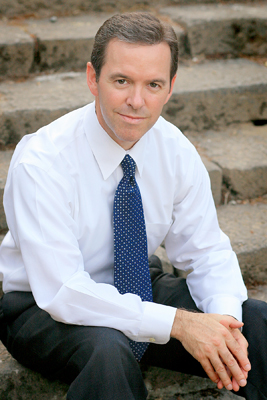 JET alum Rob Cornilles, a sports business consultant, has won the Republican primary for a seat in the U.S. House of Representatives representing the Portland-area district. The primary was part of a special election being held in the wake of the resignation of David Wu (D-Oregon) who resigned earlier this year due to allegations of sexually inappropriate behavior. Cornilles was also the previous Republican winner and lost to Wu in a close race in the last election.
JET alum Rob Cornilles, a sports business consultant, has won the Republican primary for a seat in the U.S. House of Representatives representing the Portland-area district. The primary was part of a special election being held in the wake of the resignation of David Wu (D-Oregon) who resigned earlier this year due to allegations of sexually inappropriate behavior. Cornilles was also the previous Republican winner and lost to Wu in a close race in the last election.
Cornilles will next face the Democratic primary winner Suzanne Bonamici, an Oregon state senator.
Here’s a link to the full article: http://www.katu.com/news/local/133507753.html
Here’s a link to Rob’s campaign website: http://www.cornillesforcongress.com/
BTW, if anyone knows Rob’s prefecture and years on JET, please post here or e-mail to jetwit [at] jetwit.com. Yoroshiku!

Suzanne Bonamici (D) (left) and JET alum Rob Cornilles (R) (right)
Summary of JETAA USA Fund disbursements
***************
Thanks to JETAA USA Country Representative (and JETAA USA Fund Committee member) Megan Miller (Hyogo-ken) for the following summary of the JETAA USA Earthquake Relief Fund’s disbursements. It was originally an e-mail sent to the JETAA USA chapter officers Google Group which has been modified slightly for posting here:
Dear US Chapters,
The fund committee has been hard at work and has finalized the donations for the $76,000+ we have raised so far. I’d like to thank the committee as well as the folks at JETAANY for all of their hard work during the past 8 months, and I’d also like to thank all of you for your amazing fundraising efforts. News of JETAA’s collective, world wide fundraising efforts as JET Alumni is very much on the radar screen in Japan. It is great that we can support the people of Japan and also demonstrate the value of our network and our commitment to Japan at the same time.
To recap the fund committee’s decision, here is where we are allocating the funds raised to date:
1. Hope for Tomorrow – $25,000 (http://hope-tomorrow.jp/)
A major challenge that high school students from the Tohoku region will face is to keep from falling behind students from elsewhere in the country who are studying for their college entrance exams. The students in Tohoku graduating this March had completed their exams by the time of the earthquake, but the ones who will graduate next year are liable to fall behind due to the length of time schools have been shut down, the absence of cram schools and other supplementary educational activities during their senior year, and the trauma and family tragedies that many have to face. On top of this, they need sufficient resources to even take the university exams, which tend to require travel to Tokyo, Sendai or Hokkaido. The exam fees are likely to be waived for many students, but there is no system to support their personal travel, lodging, meals, etc. when they leave their hometowns to take the entrance exams. In many cases, these expenses can easily exceed US$1,000, which will be difficult for families who have lost their homes and businesses to muster.
In response, a group of Tokyo volunteers has launched a new NPO called “Hope for Tomorrow” that plans to help support students by covering these expenses. They have been in touch with the main high schools in Kessennuma and Ishinomaki about this initiative. Kessennnuma had the greatest need, so they have come to an agreement with the high school to start supporting their students, and they hope to expand to other schools, including Ishinomaki’s high school. They are also interested in expanding to Rikuzentakata and open to other suggestions from us about other places. (In May, they tried to speak with the Rikuzentakata authorities as well as those in the neighboring town, Ofunato, where students were attending high school since Rikuzentakata’s high school was badly damaged, but were unable to have discussions due to the overwhelming challenges school officials were facing. However, they hope to try again soon.) In addition to the helping with the exam fees, they also wish to provide mentoring services to the students and other support that can aid them before and after their exams.
Update: They have expanded to Takata High School (the Rikuzentakata HS, although temporarily being operated in an empty school in Ofunato), because of our funds. Takata High School is delighted, and things are all firmed up now. They are also operating in Kessennuma, and might expand into Ishinomaki or elsewhere if there is additional funding.
2. E.Pa+Ch – $25,000 (http://soup1993.com/epatch.html)
E.Pa+Ch stands for Youth Empowerment Iwate (direct translation: Empowerment through Participation and Challenge). This group was created by a professor at Iwate Prefectural University (IPU) who has been active in mobilizing college volunteers to work in the disaster zone through a project called “GingaNet.” The group is planning to launch a major initiative throughout the prefecture to provide tutoring to and study rooms for middle school students who have fallen behind in their studies, with IPU students acting as volunteer tutors. (This may be expanded to high school students taking university entrance exams, in which case professional juku teachers will need to be employed). The board of education expressed support for this, and the IPU professor, Yamamoto-sensei, is going to continue developing the program in consultation with the board. This innovative program was launched on Nov 1, and it possibly will be a model for other programs around Tohoku. CR Jess Wilcox and Fund Committee member Jim Gannon were interviewed regarding our involvement. Read the article here: http://www.yomiuri.co.jp/dy/national/T111104005277.htm
3. Rikuzentakata Board of Education – $10,000
This direct contribution to the BoE will help alleviate some immediate needs of the schools, possibly including the hiring of a second JET for the area. There is currently a JET in RT who replaced Monty Dickson and the BoE would like to hire a second.
4. Taylor Anderson Memorial Fund – $5,000 (http://www.st.catherines.org/tayloranderson )
Many of you are already familiar with the work that the Anderson Family has been conducting. We have made a $5,000 donation to their fund to demonstrate our collective support.
5. Grants for 2-3 JET-related orgs – $10,000+ (To Be Finalized)
We are working with Paul Yoo of volunteerAKITA and Living Dreams who worked with Mike Maher King (Smile Kids Japan). Our grants will help support their grass roots efforts of volunteering in the area, bringing in needed supplies, and ‘filling in the cracks’ where other NGO’s are unable to assist.
TOTAL = $76,000+
Also, many of you might be aware that the JETAA international meeting was held in Tokyo from Oct 21-22. The meeting was covered and televised by NHK news. We also met with various government ministers who thanked us for our efforts to support Japan and asked us for advice on improving the JET program.
After the meeting we volunteered alongside current JETs in Rikuzentakata. We are doing a write up of that emotional experience and will send it to you in the coming days. Being in Rikuzentakata really drove home how important our efforts are. We have the power to get our funds directly in the hands of the people making decisions on the reconstruction effort.
To that end we would like to encourage JETAA chapters to continue fundraising. We now have connections on the ground and can help deploy funds efficiently and effectively. We have been notified that JETAANY will not be able to host the fund next year due to tax reasons, but we will work to find another nonprofit chapter that can help support us. Thank you again JETAANY for all the extra work you took on this year to make the fund a reality!
Lastly, it is always helpful when the JET alumni community is able to remind others of the ongoing needs in Tohoku and share news of JETAA’s accomplishments with others. I strongly encourage each of you and your chapter members to reach out to local news publications, church newsletters, your college and HS alumni magazines, work newsletters, chapter newsletters, etc. A great deal of information can be found on JETwit and the JETAA USA website. You can also contact members of the JETAA USA Fund Committee or local chapter officers if you need additional information or an official representative or spokesperson.
Stay tuned for more detailed information to follow.
Daily Yomiuri: Study halls opened in honor of “Monty-sensei” in Rikuzentakata
*******************
Update 11/07/11: The Ministry of Education has apparently been impressed enough by Youth Empowerment for Iwate to send a team to observe them. And fyi, the group now has a website as well: http://soup1993.com/epatch.html
*******************
There’s a nice Daily Yomiuri article (“Study halls opened in honor of ‘Monty-sensei‘”) on Monty Dickson and the contribution JETAA USA will be making to the Japanese non-profit Iwate Youth Empowerment (which is translated in the article below with a different name).
Though not quoted in the article, JETAA USA Fund Committee members Jessyca Wilcox and Jim Gannon (Ehime-ken, 1992-94) were both interviewed for background. Apparently the program launched on November 1 and they were surprised at the level of demand, receiving 100 applicants and 45 students on the first day.
*************************
Study halls opened in honor of ‘Monty-sensei’
http://www.yomiuri.co.jp/dy/national/T111104005277.htm
Takayuki Fuchigami and Kentaro Sugino / Yomiuri Shimbun Staff Writers
RIKUZEN-TAKATA, Iwate–Special study halls providing self-study sessions to primary and middle school students have opened in Rikuzen-Takata to honor an American assistant language teacher who was killed by the March 11 tsunami.
Montgomery Dickson, a native of Alaska, was scheduled to teach English at 16 primary and middle schools in the city for two years until last August.
Dickson, who was called “Monty” by local residents, gave free English classes to children and had a dream of becoming a Japanese-language teacher. At drinking parties with his coworkers, he sometimes performed manzai comedy and sang enka songs.
Noboru Sato, the owner of a bicycle shop in the city that Dickson bought a mountain bike from, was his close friend. They had dinner and
drank together almost every night.
However, both were killed by the tsunami. Dickson died at the age of 26, while Sato was 69 years old.
Sato’s granddaughter Sayaka, 15, recalled that “Monty was like a member of our family.”
After learning of Dickson’s death, a group of former ALTs (JETwit note: The “group” is actually the JETAA USA Earthquake Relief Fund Committee) decided to use about 20,000 dollars (1.5 million yen) of donations they collected for quake-hit areas for projects to support Rikuzen-Takata.
The group talked with the city’s board of education officials about possible ways to use the donations. They agreed to open study rooms called “Manabi no Heya.”
The study halls, operated by the city’s education board and Empowerment through Participation and Challenge (JETwit note: aka Iwate Youth Empowerment), an Iwate Prefecture-based organization, have been opened at three primary and middle schools.
During sessions at the halls, which are open three times a week in the evening and on weekends, students study on their own and can ask questions to former teachers and cram school instructors. The operators intend to run the sessions for two years.
At the city-run Daiichi Middle School, the first Manabi no Heya study session was held Tuesday. A total of 45 students studied for two hours from 7 p.m. in three classrooms.
Mai Sato, 13, a second-grade student at the school who lives in a temporary housing unit, expressed her appreciation. “I was so depressed by the death of Monty-sensei. But [thanks to him] this study hall was opened. I’m happy,” she said.
Naoko Watanabe, 36, an office worker in Tendo, Yamagata Prefecture,
who was engaged to Dickson, expressed her hopes for his legacy.
“I think Monty is happy [to know about the study halls]. I hope Monty lingers in the memory of children in Rikuzen-Takata for a long time,” Watanabe, who once studied in the United States, said.
On the morning of March 11, Dickson was asked by his friend to translate a phrase from the essay “Koan no Taimatsu” (Ogata Koan’s torch), written by historical novelist Ryotaro Shiba (1923-1996) from Japanese into English.
The English translation was left on a piece of paper: “There is nothing as beautiful as dedicating oneself for a cause.”
The translation was given to Shelley Fredrickson, Dickson’s elder sister, who lives in Anchorage, Alaska.
Referring to the phrase, Fredrickson, 45, said, “Monty always made himself available to anyone who needed him.
“I’m so proud of him and all he had accomplished. I’m finding his inspiration is still flowing and continuing to make an impact on people who knew him as well as those that did not.”
(Nov. 5, 2011)

